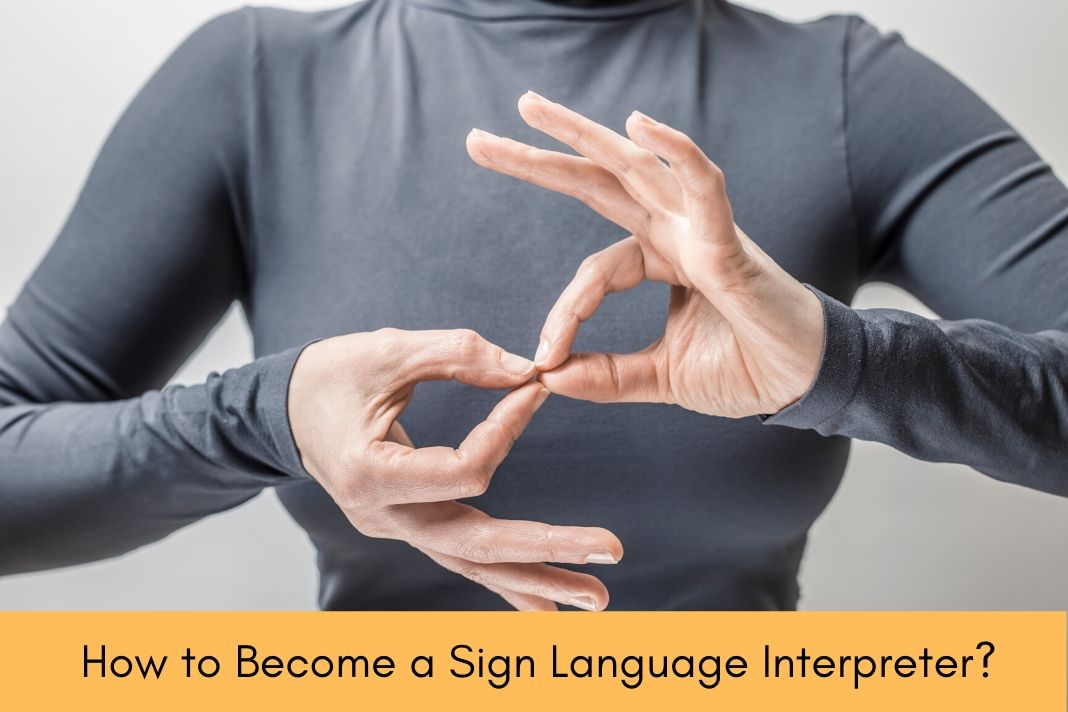
For you to become a successful sign language interpreter, one needs a lot of training and practice. Dedication, persistence, and patience are a must for a sign language interpreter, as they help the deaf and hard to understand the language. And, they use techniques such as signing, lip-reading, and body language.
How to Become a Sign Language Interpreter
A sign language interpreter translates spoken language into signs and facial expressions to the impaired people. They convert spoken language into sign language for the impaired to understand. Then interpret the sign language back into spoken language. Accuracy in interpreting is vital in this profession. Sign language interpreter jobs are sensitive as well as risky.
For instance, how can a deaf patient communicate the issues with their doctor? This is when a sign language interpreter plays the role of a medical sign language interpreter. They observe the deaf patient’s sign language and interpret that to the doctor. And then listen to the doctor’s advice, medical prescriptions, and communicate it to the patients.
Sign Language Interpreter Jobs:
A sign language interpreter’s job is highly challenging. A high degree of linguistic and cognitive skills is required to interpret sign language. A sign language interpreter fully understands the subject at hand. He/She uses a combination of body language, facial expressions, and fingerspelling techniques. This combination promotes communication between hearing and deaf people.
The critical sign language skills include listening skills, communication skills, and good memory. The duties and responsibilities that define the sign language interpreter job description are :
Interpreting services and conversation, meeting, and training sessions to deaf employees and other employees who do not use sign language.
Sign language interpreters require active listening, research, interpreting, and sign language skills. They should use technology to render interpretation services to clients from a distant location.
Video Relay Systems (VRS) allows deaf or hard-of-hearing people to communicate with hearing persons through the telephone system. The VRS caller (impaired) describes with the VRS CA, a qualified sign language interpreter using a television or a computer with a video camera device and a high-speed Internet connection. The VRS CA then calls the party the VRS user desires to call and interprets the conversation in sign language with the VRS user and by voice with the called party. No typing or text is involved throughout the process.
[Also Read: Best Jobs for Deaf People ]
Steps in Becoming a Sign Language Interpreter
Step 1: Get a Degree
To pursue a bachelor’s degree, with a major in the English language is an added advantage. The cultural aspects of communication are covered in the course of education. Bachelor’s degree strengthens the foundation of training in sign language.
Step 2: Enroll in ASL (American Sign Language) Training Program
Many community colleges offer this training program. However, this training program can be done online also. It usually provides courses that are 15 weeks and provide training in deaf literature, sign language, and the English language.
Step 3: Gain Basic Work Experience
Forget the pay and work with those who have hearing disabilities to understand how they communicate. Spend time with deaf people.
Step 4: Attain certification from the RID (Registry of Interpreters for the Deaf, Inc.
To attain certification from this organization, one must have a high degree of knowledge in sign language. Different colleges offer various courses to prepare for the RID exam. After obtaining a certificate, you can become a professional sign language interpreter.
Education & Skills Needed
Ever wondered, How long it takes to become a sign language interpreter? Well, it takes two years for an associate degree or four years for a bachelor’s degree. To take up a career as a sign language interpreter, desired applicants should have a minimum of high school diploma or equivalent & graduation from an Interpreter Training Program.
A sign language interpreter should have a thorough knowledge of technical and human resource vocabulary to facilitate communication in the workplace. They should communicate and build a relationship with hearing and hearing-impaired people as well.
Applicants must have the required skills to provide suitable and improved services. Interpreters should be flexible enough to work within a changing schedule and should be willing to work as a part of the team.
How Much Does a Sign Language Interpreter Make
As an interpreter, you can either work as a staff employee, a freelance interpreter, or for an agency. According to the RID, how much does a sign language interpreter make is challenging to predict mostly because the sign language interpreter salary and jobs differ with types of industry. Those working in scientific, technical, and other professional services get paid more than those who work in elementary and secondary schools.
The United States Bureau of Labor Statistics, states that the median pay of a sign language interpreter is $49,930 per year and a mean hourly wage of $ 29. It has also predicted that the jobs for interpreters would increase by 19% between 2018-2028.
Sign Language Interpreter Certification
In the United States, the American Sign Language (ASL) certification for English interpreters is done at the national level. The path to becoming a certified interpreter is to become fluent in both ASL and English. You can then get a bachelor’s degree in deaf studies, interpreting, and linguistics. Work for a few years as an uncertified interpreter and then get NIC. Registry of Interpreters for the Deaf, Inc. (RID) offers National Interpreter Certification (NIC)(1).
Sign language interpretation is a sensitive field, and it should be practiced with utmost devotion, dedication, and persistence. Education and sharp linguistic skills are the two essential factors in becoming a successful interpreter.




